A few months ago I wrote about the Hurricane Michael quilt drive and a string block request. Well, it’s update time. This small group of quilters at the church have exceeded all expectations. Thus far, with help from other guilds and donations from around the country, they have made 363 quilts and blankets! Check out the photos below!! Another batch of stuff will be delivered tomorrow, just in time for the holidays. They are grateful for everyone’s support as you can imagine. I’ve been asked by several quilters if the group is still collecting string blocks and so forth. Sharon at the guild tells me that while they are still happy to take some donations, they prefer no blocks at this time. They will gladly still take finished quilt tops or completed quilts. You can make quilts in any size you wish, for a child, a lap or an adult.
Please send quilt tops and completed quilts to the address below. They are so grateful for all the support. Reminder: they prefer no blocks at this time.
UMW Quilting Group, Hurricane Quilt Drive,
Aldersgate United Methodist Church,
6610 Vaughn Road,
Montgomery, Alabama 36116
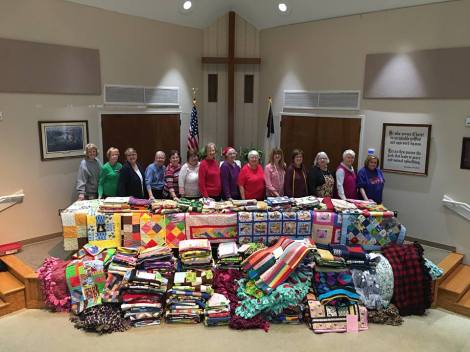
The Aldersgate quilting group with just “some” of their completed 363 quilts!! They haven’t stopped sewing since the drive was started and look at this!!
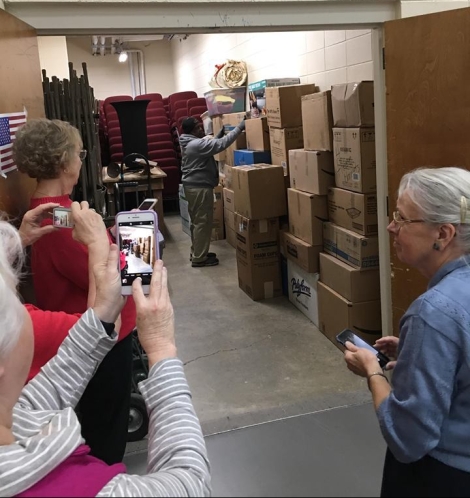
Boxed and ready to deliver. Wow or wow what an achievement
I contributed some blocks, quilt tops and other stuff previously, but wanted to make one more little quilt for the Hurricane Michael drive. Despite making lots of string blocks for the drive, I still have an overflowing bin. I tried something new and used newspaper for the foundation instead of fabric. Here’s a little tutorial if anyone needs one.
Scrappy Half Square Triangle (HST) String blocks
using old newspaper as the foundation.
Materials Needed:
String scrap pieces: Strip pieces should preferably be no thinner than 1″ and no thicker than 2.5″ wide. Any length strip is fine. You will them at different lengths, and some must reach the full diagonal length of your block.
Old Newsprint cut in squares, larger than needed to allow for excess before cutting your final block. For example, I cut my foundations 11.25″ square for the final blocks to end up 10.5″.
Solid yardage: Take one of the newsprint squares and fold it in half on the diagonal. Your solid fabric triangles will need to be cut a half-inch larger than the newspaper triangle. If this is confusing, cut a square of solid fabric that’s larger than your 11.25″ foundation squares, say 12″, then fold it on the diagonal and cut in half, that’s your triangle size.
Rotary cutter: To trim the final blocks, a rotary cutter is helpful along with a square ruler that matches your final size. I recently bought a 10.5″ ruler and it’s a great help for this project of similar size blocks.
1. Fold one foundation paper in half on the diagonal. Using a pen or pencil and mark a 1/4″ inch seam line from the folded mark. This will be where you place your first solid fabric triangle. One little tip that I can share is that, while I draw the 1/4 inch line, when I sew, I move my machine foot slightly (Babylock has an easy setting to do this) so that I have a seam allowance that’s a tad over a quarter-inch. This extra bit gives me added coverage for those strings that slip and try to pull out of the seam allowance.
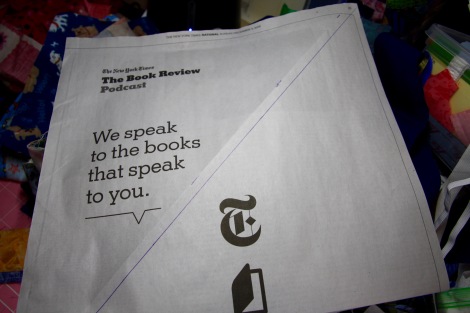
Notice the line that’s drawn 1/4″ just from the fold line on my foundation paper.
2. Place a solid fabric triangle across the diagonal fold to be lined it up with your 1/4″ marking line. Make sure the triangle completely covers that half of the newsprint. If not, adjust it slightly.

3. Line your first string right on top of the solid triangle on top of the solid triangle on the 1/4″ diagonal line. The strip should be facing right side down and you will only be seeing the “ugly” side of the strip. Pin in place carefully going through all the layers. Line your presser foot up with the edge and begin sewing. You should be sewing directly onto the original fold line below, even if you can’t see it from the top. Remove the pins, flip the strip and iron it flat. 
4. Using the edge of the previous flipped and ironed strip (the blue and yellow in this photo), place the next strip right sides facing and line it up along the edge of your first strip. You can use pins again to keep things steady. Sew again just as before, remove pins and then flip and iron this second strip (red in my photo). 
5. Keep sewing strips using this method. As you can see, the length of your strips gets smaller and smaller. Be sure to cover the tip of the block as well, even if there’s only a smidgen of fabric needed. Iron the final block with all pieces right side up. The back of your block should look like this.

6. Place your ironed block onto a cutting mat. 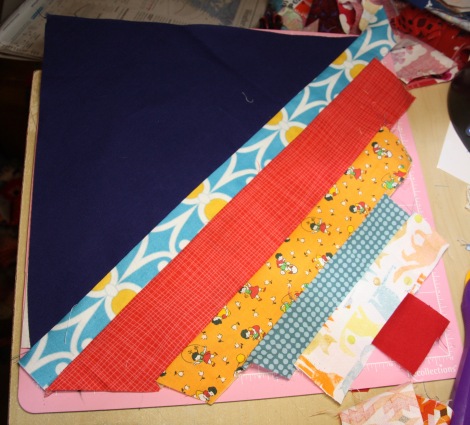
7; Carefully place on your squared-up ruler if you have one. If there is one, use the half diagonal line as your guide. Be careful at this point and make sure that the entire block will cover your desired size. When certain of the ruler placement, go ahead and trim your block with the rotary cutter.
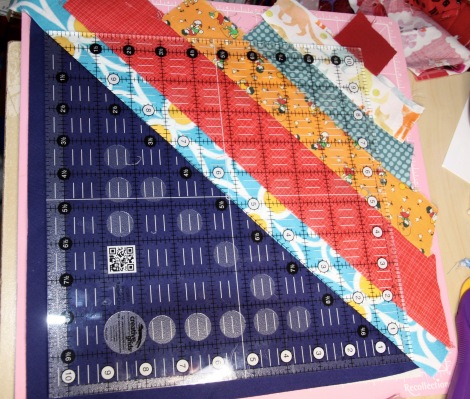
8. Your block is finished and should look like this.

The best part of making these blocks, is the fun you can have arranging them in a myriad of different ways. Try out different ideas or look some up on Pinterest. The options are endless. My quilt top still needs a border but I do like how it looks.
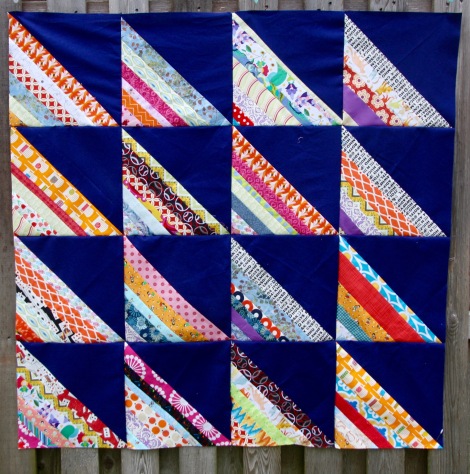
This quilt top will be for Hurricane Michael and will maybe become a lap quilt for a child. It still needs a border but I am liking it thus far.

The best part of a scrappy quilt is that it can have animals or other novelty prints. It seems that anything can be an eye-spy quilt. I spy baseballs, a cat, a little girl reading, a deck or cards etc…
I liked using newspaper as a foundation, even if it was a little messy. Here are some Frequently Asked Questions for anyone wanting to attempt the same thing.
STRING QUILT FREQUENTLY ASKED QUESTIONS:
Why do we need foundation paper at all for string blocks? Well, it helps them stay uniform, even and keeps the strips orderly and flat as you sew. In addition, most of our string scraps will be cut without the bias in mind, therefore they will stretch very easily. Sewing onto paper (or old fabric as I usually do) will keep the strips manageable and help prevent stretching.
What is the benefit of using old newspapers for your foundation? It’s readily available, i.e. cheap, and comes in huge sheets that you can cut to any size you need. It reminds me of the olden days when ladies used what they had and didn’t spend unnecessary money. The newspaper tears off so easily when the block is done. (Every now and then you’ll see antique quilts that still have the papers on the back. Imagine the fun in getting to see the old pages with articles from days gone by.) In addition, unlike fabric foundations that stay with the quilt, the paper gets removed and therefore the quilt is lighter. I have made string quilts with fabric and they are mighty heavy when complete. If you like a weighty feel to your quilts, then go for it.
What are the disadvantages to using old newspapers for your foundation? The ink on the pages really does come off on your hands. You know from reading the newspaper what I’m talking about. I washed my hands frequently, but it was a concern as I was working. If you plan to use mostly white strips, I would recommend you try to get unprinted newsprint from a moving supply company or a friend. However, if you’re trying to be thrifty, just use the newspaper and remember to wash your hands frequently.
That’s it for today. Be sure to stay tuned as I write next time about tackling flying geese with the monthly block request for Covered In Love.

I like to use old telephone books for string piecing. They are at least a year old when you use them so the ink is dry and doesn’t rub off. Unfortunately, they are a lot smaller than they used to be. I can still get 8″ or 6 1/2″ blocks from them.
LikeLike
I love the idea of old phone books. However, I don’t see them anymore. But yes, the yellow books given out to neighborhoods are much smaller than before. Alas, we will make do with whatever works. My newest idea is to buy unprinted white newsprint online for a deep discount. It comes in a ream 8.5 x 11″ and can even go through the printer for EPP work.
LikeLike
Pingback: Great Minds String Alike | That Fabric Feeling·
Pingback: Charity Sewing Brain | That Fabric Feeling·
Wow! That’s a lot of quilts, and I know my blocks are in there somewhere. Love the new string quilt – thanks for the tutorial!
LikeLike
Thank you so much for stopping by. Yup, your blocks are somewhere in there, now back in Florida being readied for distribution. I’ll share the completed string quilt top next time, but it’s just about ready to send to be quilted.
LikeLike
Thanks for the string block tutorial — I love making string quilts — I like to sew string blocks and watch TV in the evenings.
LikeLike
They are addictive aren’t they? I haven’t been able to watch TV and sew, but great multi tasking on your part! Thanks for stopping by.
LikeLiked by 1 person
What wonderful quilts you are creating and donating! Great string block tutorial!
LikeLike
Thanks so much. I have a thing for string quilts, which must seem obvious. There’s just so many ways to use them!
LikeLike